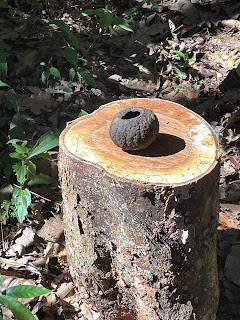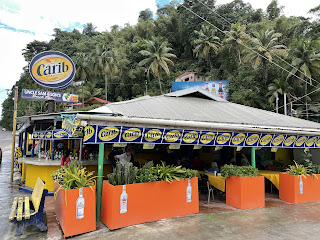November 25, 2022
As the ship was anchored off Santarem that Friday morning, those going for a hike in the rain forest, boarded tenders and transferred to the city docks. It is a very busy commercial port. On the tender, Gym noticed that several large freighters were tied up there. Once ashore, the tour group walked up to meet a rather dilapidated tour bus. It would be a long 90-minute ride to the conservation area, in a bus that boasted air conditioning but had all the windows open. Despite the less than premium transportation, the charismatic guide provided Gym etal with loads of interesting facts about the area, as they drove out of town to the south, and up into the highlands.
First off, the guide let on that the freighters were loading soybeans. The area around Santarem produces a significant quantity of soybeans and rice which is loaded for export, right there on the Amazon. Export destinations are countries all over the world. The highway was busy with farm trucks and semi-trailers travelling in both directions. On the outskirts of town, there were farm machinery dealers, fertilizer stores and a large grain storage facility. Many of the workers in this city of about 300,000 were obviously employed in agri-businesses.
Once out of the city, there was field after field of soybeans. The odd thing was that each field had large trees randomly located throughout the crop land. The guide explained that these were Brazil Nut trees and that it was the only tree that it was illegal to chop down. There was an obvious economic reason for protecting these trees but the farmers must be frustrated when they work these fields because they have to go around the big obstacles.
When the bus reached the conservancy, it left the highway and proceeded down a dirt road to a camp about two miles away. The camp was in a small clearing, surrounded by the jungle. It had been extremely hot that day but here in the jungle, it was a little cooler because of the shade. There were several interesting things right there in the clearing. The guides pointed out a Bullet Ant nest and described the very painful sting of these large and imposing ants. Gym made a mental note not to touch them. Then, there was also a rubber tree sapping demonstration. It was important to make diagonal cuts with your cutter so as not to kill the tree. Gym did touch the latex and it dried almost immediately on his finger. Nearby, the hikers were shown the massive Kapok tree that is very useful as it provides biofuel from the seeds and cotton for mattresses from the seed pods. The bark can be boiled to make medicine that treats diabetes and headaches, it also is helpful as a diuretic and aphrodisiac.
Gym and his fellow hikers then broke into smaller groups and traipsed off into the jungle, observed two types of termite nests, different species of ants and other fascinating flora and fauna shown in the pictures. The forest was always alive with the sounds of birds, insects and animals, protecting their turf. The forest floor was covered in damp leaves and rotting logs. The ground was uneven and the hikers had to be careful not to step in holes or on unstable logs. At one point Gym pushed off a sturdy looking tree beside the trail and a few seconds later heard a loud crack as the tree broke at the base and fell across the trail behind him. As always, Mrs. Gym was in front of him so she was never in danger. The guide laughed and told me I wasn't as strong as I thought, the tree had been undermined by termites.
Aside from some uncertain footing, Gym enjoyed the hike. He really found the tour guide and the accompanying local naturalist, to be very knowledgeable and very animated in their discourse. After the hike and without losing anyone, the hikers re-boarded the buses for the return trip. When they reached the river, Gym was struck by the heartfelt thanks from the tour guide who let the group know that this tour was first of its kind in three years. We were the first cruise ship to come back to the Amazon since the advent of the pandemic.
Sure, Gym has some liberal leanings. He does care about the environment. He is worried about global warming. But these people need to feed their families and tourism helps with that. In turn, we learn more about this fragile environment and hopefully can turn turn that enlightenment towards helping the best conservation initiatives.
The ship weighed anchor that evening during one of the most beautiful sunsets Gym had ever seen. Then, the ship continued westward towards the city of Manaus.
Stay tuned!

Freighters on-loading Soybeans
 |
| A Brazil Nut tree in the front yard of this farm can not be cut down by the farmer |
 |
| A brazil nut shell that an agouti has broken open and consumed the ripe fruit |
 |
| A special tool used to cut diagonal grooves in a rubber tree |
 |
| A red termite mound on the side of a tree |
 |
| Our very good main guide, Paulo |
 |
| A tree with a spiky defence |
 |
| Mrs. Gym by the massive Kapok tree |
 |
| Another termite mound, this time black ones |
 |
| Sunset at Santarem |











































